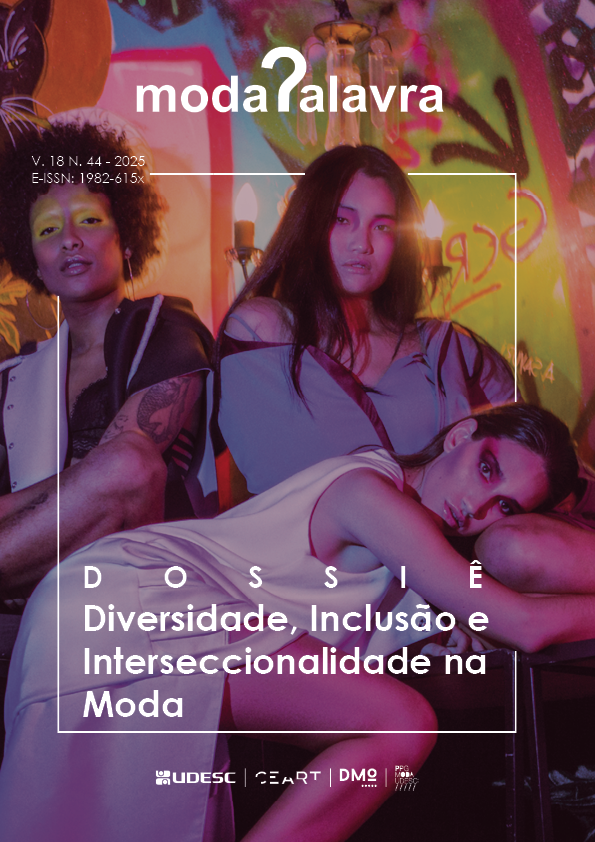Una reflexión sobre la constitución de drag queens en diálogo con las personificaciones de Japón
DOI:
https://doi.org/10.5965/1982615x18442025180Palabras clave:
drag queen, onnagata, fabulacíonResumen
Las drag queens son un referente en la historia del teatro y la per-formance, en las discusiones de género y en la investigación de moda. En Occidente, esta marca de diversidad emerge con más fuerza en los medios de comunicación, a partir de la década de 1990 en Estados Unidos. En Asia, se puede decir que existe un diálogo entre el Drag y las Artes del Cuerpo, que se remonta al siglo XVII, y la ropa y el maquillaje terminaron actuando como activadores corporales, superando así la noción tradicional de ves-tuario. Este artículo tiene como objetivo discutir la constitución performativa de las Drag Queens, específicamente documentada por Cláudia Guimarães en São Paulo, y de los actores onnagata del teatro kabuki en interfaz con algunos personajes de la dan-za butoh de Kazuo Ohno. La metodología involucra la investiga-ción bibliográfica apoyada principalmente en la teoría corpomedia (Katz; Greiner, 2015) y una investigación iconográfica para anali-zar cualitativamente las singularidades de los cuerpos fuera de los estándares heteronormativos, señalando cómo la moda trans ha activado cuestiones políticas y existenciales que ya han cumplido cuatro siglos y que pueden considerarse un dispositivo fabulatorio para hacer explícitas las subjetividades.
Descargas
Citas
ARIOSHI, Sawako. Kabuki Dancer: a Novel of the Woman who Founded Kabuki. Trad. James Brandon. Tokyo: Kodansha International, 1972.
AZOULAY, Ariella. The Civil Contract of Photography. Zone Books. p. 15-31, p. 85-135 e p. 375-411. New York, 2008.
BRAGA, Joana; BOURROUL, Camila, HAMPSHIRE, Maria Paula. A Teoria do Círculo Mágico e Drag Queens: um estudo sobre práticas de consumo, rituais imersivos de transformação e construção de identidade. Monografia (graduação). ESPM-SP, 2020.
DE VOS, Patrick. Jouer et Vivre en Femme, Statut Corporel de L’Onnagata du Kabuki in Le Corps en Jeu. Paris: CNRS, 2000, p. 133-150.
FELITTI, Chico. Rainhas da Noite: as travestis que tinham São Paulo a seus pés. São Paulo: Companhia das Letras, 2022.
GREINER, C. O Corpo, pistas para estudos indisciplinares. São Paulo: ed. Annablume, 2005.
GREINER, C. Leituras do Corpo no Japão. São Paulo: n-1, 2015.
GREINER, C. Fabulações do corpo japonês. São Paulo: n-1, 2017.
GREINER, Christine. “Fabulações da dor”. In PAIS, Ana. Dossiê Dramaturgias dos Afectos: Sentimentos Públicos e Performance. Revista Dramaturgias, Periódicos UnB N.18 (2021), p. 170-180.http://periodicos.unb.br/index.phd/dramaturgias/article/view/41286/31941.
HAMPSHIRE, Maria Paula. Retratos transviados: uma leitura política da construção midiática de corpos dissidentes. Dissertação de Mestrado orientação Christine Greiner. PUC-SP, 2023.
HOSOE, Eikoh. Corpos de Imagens. Realização: Sesc São Paulo, 2014.
KATZ, H.; GREINER, C. (Orgs.) Arte e Cognição, corpomídia, comunicação e política. São Paulo: ed. Annablume, 2015.
KATZ, Helena. “Corpar, porque corpo também é verbo”. In: BASTOS, Helena. Coisas vivas: fluxos que informam. São Paulo: ECAUSP, 2021.
LAWRENCE, Tim. A history of drag balls, houses and the culture of voguing. Londres: Soul Jazz Books, 2011.
LEITER, Samuel L. A Kabuki Reader. (Ed.) Nova York: M. E. Sharpe, 2002.
OLIVEIRA, Cristiano Nascimento; ARAUJO, Leonardo Trindade. Reconfigurações do consumo televisivo no reality show RuPaul’s Drag Race. Culturas Midiáticas, ano IX, n. 17, p. 293-309, 2016.
PRECIADO, Beatriz (Paul). Manifesto Contrassexual, práticas subversivas de identidade sexual, trad. Maria Paula Gurgel Ribeiro. São Paulo: edições n-1, 2014.
UNO, Kuniichi. Hijikata Tatsumi, pensar um corpo esgotado, trad. Christine Greiner. São Paulo: n-1, 2018.
XIANG, Zairong, Antigos Caminhos Queer, trad. Paula Faro e Gil Lourenço. São Paulo: ed n-1, 2024.
Publicado
Cómo citar
Número
Sección
Licencia
Derechos de autor 2025 Maria Paula Hampshire, Christine Greiner

Esta obra está bajo una licencia internacional Creative Commons Atribución-NoComercial 4.0.
Al enviar un artículo para su publicación en ModaPalavra e-periodico, el (los) autor (es) aceptan los siguientes términos:
- Los autores mantienen los derechos de autor y otorgan a la revista el derecho a la primera publicación, con el trabajo licenciado simultáneamente bajo Creative Commons Attribution-NonCommercial 4.0 International, que permite compartir el trabajo con reconocimiento de autoría y publicación inicial en esta revista, sin pago;
- Los autores pueden utilizar los mismos resultados en otras publicaciones después de la primera publicación, siempre que indiquen ModaPalavra e-periodical como medio de publicación original;
- Los autores pueden asumir contratos adicionales por separado solo después de la publicación inicial en ModaPalavra e-periodical, siempre que indiquen ModaPalavra e-periodic como el medio de publicación original;
- Se permite y anima a los autores a publicar y distribuir su trabajo en línea (por ejemplo, en repositorios institucionales o en su página personal), solo después del proceso editorial y la primera publicación, siempre que indiquen el ModaPalavra periódico electrónico como medio de publicación original;
- Para indicar ModaPalavra e-periodic como medio de publicación original, el autor debe seguir el texto modelo: "Este artículo fue publicado originalmente por ModaPalavra e-periodic, bajo la licencia CC BY NC, en su volumen [insertar volumen], número [ insertar número] en el año de [insertar año], y se puede acceder en: http://www.revistas.udesc.br/index.php/modapalavra/ ";
- Las opiniones expresadas en los artículos son responsabilidad exclusiva de los autores y no reflejan necesariamente la opinión de la revista. La publicación de artículos, fotografías y dibujos fue previamente autorizada por los responsables o sus representantes para su publicación en ModaPalavra e-periodic.









